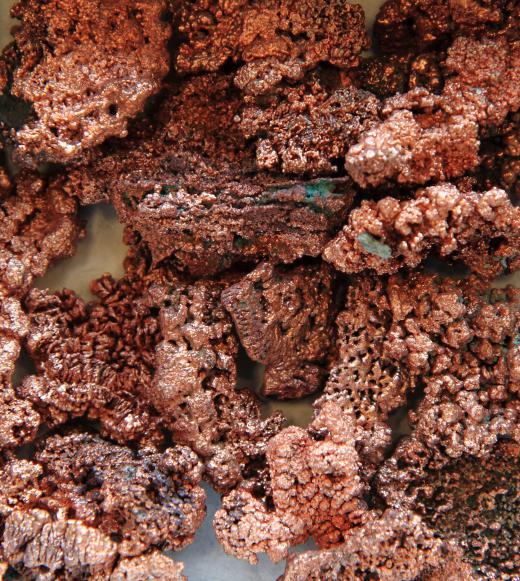Electrometallurgy is a term used for processes that refine or purify metals using electricity. It can also be a general term for electrical processes used to plate one metal with another for decorative or corrosion resistance purposes. Metal processing using electricity is generally not the first step in metals purification, but rather a later or final step used to create very pure metals for other industrial processes.
Raw ore mined from the ground can contain a valuable metal such as gold, copper or aluminum with a large amount of impurities. Some processing can be done by melting the ores at high temperatures and separating the desirable metals. These processes give metals that still can contain an undesirable percentage of minerals or other metals. Electrometallurgy can be used in a number of ways to purify or separate the remaining products.

Electrowinning is a process that uses electric current passing through a water-based bath, called a cell, to separate the metal molecules, or ions, to a rod or plate. An electrical circuit consists of a positive and negative charge and a way for electrical current to flow between them. When two charged electrodes, called the cathode and anode, are placed in the cell, the metal ions will collect on one of the electrodes. Careful control of the voltage and current flow can create very pure metal deposits. This is a common process for purifying copper from less pure copper mixtures.
Another electrometallurgy process is electrorefining, which uses greater electrical currents to heat and melt partially refined ores to extract metals. This is a common process for aluminum refining, and is called the Hall process. In this process, partially refined aluminum oxide is first made from aluminum ore called bauxite. The aluminum oxide is then mixed with cryolite, a mineral composed of sodium, aluminum, and fluorine, which melts at a much lower temperature than aluminum oxide. When the mixture is exposed to high electrical currents, it melts and produces pure aluminum metal.
Electroplating is an electrometallurgy technique where an electrical current is passed through a water-acid bath containing a dissolved mixture of metal and other minerals. An object placed in this bath and given an electrical charge can attract the metal ions to its surface, which will then plate or deposit as a thin layer over the object. This is a common process to create plated items such as chrome parts used for automobiles, motorcycles and home appliances. Electroplated metals not only have a shiny decorative appeal, but the chrome plating acts as a corrosion-resistant covering to extend the life of the part.
Another process used in electrometallurgy is physical vapor deposition. This is similar to electroplating, because a metal is deposited on another surface. The metal is electrically vaporized to give it an electrical charge, and the surface to be coated is given the opposite charge, which causes a very fine layer of metal to be deposited. A vacuum chamber where the air is removed is typically used to remove oxygen that can contaminate the product. Vapor deposition is used where water-acid solutions might damage the parts, such as in some electrical circuits. It also has the ability to form very thin layers that can be useful in electronics and some industrial processes.
